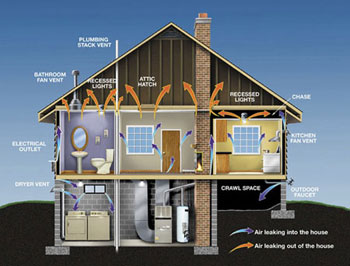USA Energy Savings
According to the United States Energy Council website:
ENERGY STAR estimates that a knowledgeable homeowner or skilled contractor can save up to 20% on heating and cooling costs (or up to 10% on their total annual energy bill) by sealing and insulating. By sealing and insulating the "envelope" or "exterior shell" of your home its outer walls, ceiling, windows, doors, and floors is the most cost effective way to improve energy efficiency and comfort.
To seal from air leakage and insulate your home:
Seal air leaks throughout the home to stop drafts, and add insulation to block heat loss in winter and heat gain in summer.
You can hire a home energy auditor who will use special diagnostic tools such as infra-red cameras, blower door tests and energy star inspections to pinpoint and seal the hidden air leaks in your home.
 Sealing Leaks Sealing Leaks
Many air leaks and drafts are easy to find because they are easy to feel like those around windows and doors. But holes hidden in attics, basements, crawlspaces and cracks and gaps in the building's construction are usually bigger problems. Sealing these leaks with caulk, spray foam, foam insulating kits or weather stripping will have a great impact on improving your comfort and reducing utility bills.
Homeowners are often concerned about sealing their house too tightly; however, this is very unlikely in most older homes. A certain amount of fresh air is needed for good indoor air quality and there are specifications that set the minimum amount of fresh air needed for a house. These are referred to as air exchanges per hour. If you are concerned about how tight your home is, hire a contractor or RESNET or BPI home energy auditor, who perform a blower door test to measure your home's actual leakage. If your home is too tight, a fresh air ventilation system may be recommended. Fresh air ventilation systems have other benefits as well. They are often equipped with HEPA air filters and assure only conditioned fresh air enters the home, making them a healthy upgrade as well as an energy efficient upgrade.
After any home air sealing project, have a heating and cooling technician check to make sure that your combustion appliances (gas or oil-fired furnace, water heater, and clothes dryer) are venting properly.
Adding Insulation
Insulation keeps your home warm in the winter and cool in the summer. There are several common types of insulation, fiberglass, cellulose, rigid foam board, spray foam and injection foam to name a few. Reflective insulation (or radiant barrier) is another insulating product which can help save energy in hot, sunny climates, especially in the attics.
When these insulation types are correctly installed with air sealing, each type of insulation can deliver comfort and lower energy bills during the hottest and coldest times of the year.
Insulation performance is measured by R-value. This its ability to resist heat flow. Higher R-values mean more insulating power. Different R-values are recommended for walls, attics, basements and crawlspaces, depending on your area of the country. Insulation works best when air is not moving through or around it. So it is very important to seal air leaks before installing insulation to ensure that you get the best performance from the insulation. See our R-value Chart for the recommended r-value near you.
To get the biggest savings, the easiest place to add insulation is usually in the attic. A quick way to see if you need more insulation is to look across your uncovered attic floor. If your insulation is level with or below the attic floor joists, you probably need to add more insulation. The recommended insulation level for most attics is R-38 (or about 12–15 inches, depending on the insulation type). In the coldest climates, insulating up to R-49 is recommended.
Spray Foam insulation is being used more and more to create an unvented attic space. The spray foam is applied to the roof line and on the gable walls to completely seal the attic space from the outside air. By doing this the extreme cold temperatures in the winter and the extreme hot temperatures are greatly reduced. Oak Ridge National Labs (ORNL) has conducted studies on this attic insulation method with great results.
|




 Sealing Leaks
Sealing Leaks